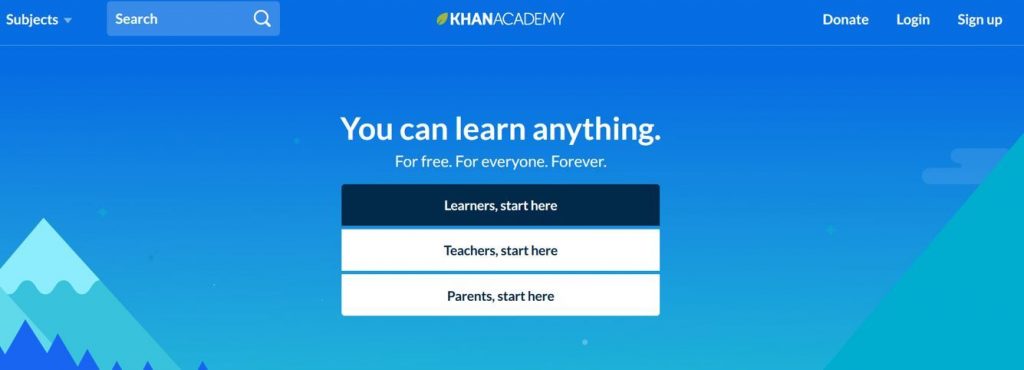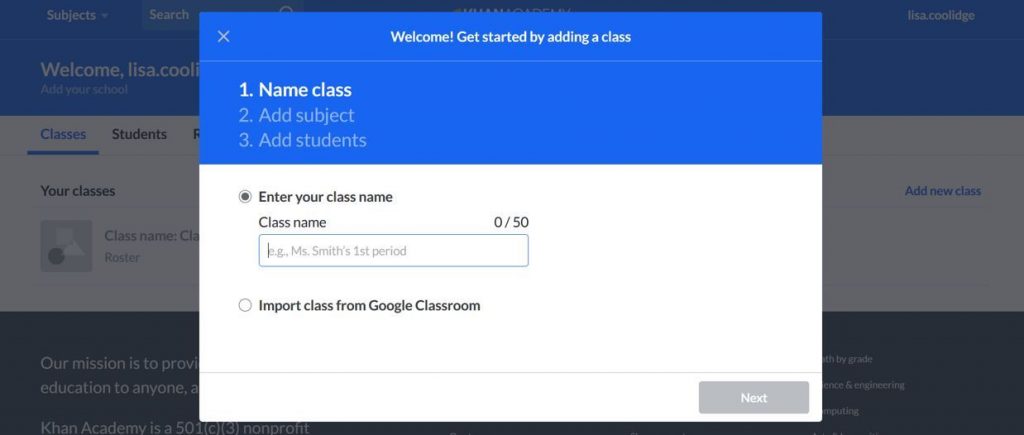For this week’s blog post we’ve been instructed to find an educational app or tool we were unfamiliar with to review and provide insights on. I wasn’t really sure what I wanted to review, because let’s be honest, I’m unfamiliar with most educational type apps (aside from Twitter maybe), so I started with a Google search for “Best Educational Apps” and chose one from the top results; the app/tool I’ve chosen to review is Khan Academy. I chose this tool because when I was first researching, it was an app that was available for Apple, Android, and desktop (10 points to Gryffindor for that one).

Khan Academy is a non-profit organization that was created as a supplemental form of online education. The lessons/lectures provided are typically related to STEM (science, technology, engineering, math) subjects, and are formatted as videos, articles, and test prep. Lessons are offered for K-8, and then high school as a collective. I started my experience with the App on my phone, and from there, explored the App as a student, creating a profile, browsing subjects, completing a few lessons, and watching a few videos. Overall, it was a pretty straight forward experience. The subjects provided are not typically in my area of interest, so I searched Sociology and Psychology to find a number of lessons in my area of interest, and continued on with those lessons! At this point, there wasn’t anything that really stood out to me — positively or negatively — but it was a neat app to explore from the comfort of my own bed.

I continued my exploration with the desktop version, and was pleasantly surprised to find the things that I did; this time, I chose to review the App as a teacher. Although I’m not overly familiarized with Google Classroom, from what I understand, the teacher version of Khan Academy is similar to the teacher version of Google Classroom, you can even import your Google Classroom!

From there, I could add a subject, add students, and assign “homework” for the lessons provided. As a teacher, I would be able to view the results from the assigned work, see what lessons students excelled at, and see where additional teachings are needed. There were some grammar and history lessons in there as well, but not near as many as the STEM subjects (I think they started with STEM, but have recently branched out).
Strengths of Khan Academy:
- Free service, so it is available to anyone with power and Internet access
- Available with Apple, Android, and on desktop computers
- Provides services for a variety of grade levels and subjects
- Lessons are short (generally 3-15 minutes)
- Videos are engaging (illustrated, and real people (not a monotone robot))
- Progress can be tracked by the student and/or teacher and/or parent.
***
At first, I really didn’t think there were any weaknesses to Khan Academy, because I was so excited about my discovery. Because of this, I decided to Google “Feedback for Khan Academy” and found a couple of things, which after reading about, really make sense. After Googling the negative aspects of the App, I took a more critical lens to it and came up with a few downfalls, listed below.
Weaknesses of Khan Academy:
- Teaching style is limited
- Not much diversity in delivery of lessons
- Aside from close-caption/subtitles there isn’t much in regard to differentiation
- Not very interactive
- Subjects are limited
- Mostly STEM subjects (humanities courses and assignments are provided, but as stated previously, there are not near as many humanities courses as there are STEM courses)
- Not always accurate

Overall, I am impressed with my discovery, and in a classroom setting, I think this tool could be used in a number of ways (as supplemental text, and not something to take over your own teaching):
- In an elementary setting, it could be a good discussion piece;
- Watch a video together as a class and then apply it to a classroom activity.
- In middle years and secondary, it could be used as a teaching and learning tool for students;
- Students choose a topic of interest, progress through lessons/videos, and teach each other about what they have learned (like a Jigsaw) working as individuals or in groups.
- Would be useful as an introduction to certain subjects;
- Short videos with a brief overview.
- For the students who work quickly, or want to do extra work;
- Assign them a topic to learn about;
- Track their individual progress on the subject.
- As a concluding piece to a unit, you could ask students to critique a video;
- With their gained knowledge and deeper understanding on a given subject, have them choose a video to critique and provide feedback on, stating things they could add to the video, things they could remove from the video, strengths, weaknesses, practical applications etc.

Have you ever used Khan Academy before? Any thoughts or feedback on what you’ve discovered? And if you haven’t used it before, is it something you’d be interested in trying out? Anyway, I feel like I’ve rambled wayyyy too long, but I hope you find some value in my rambles!

